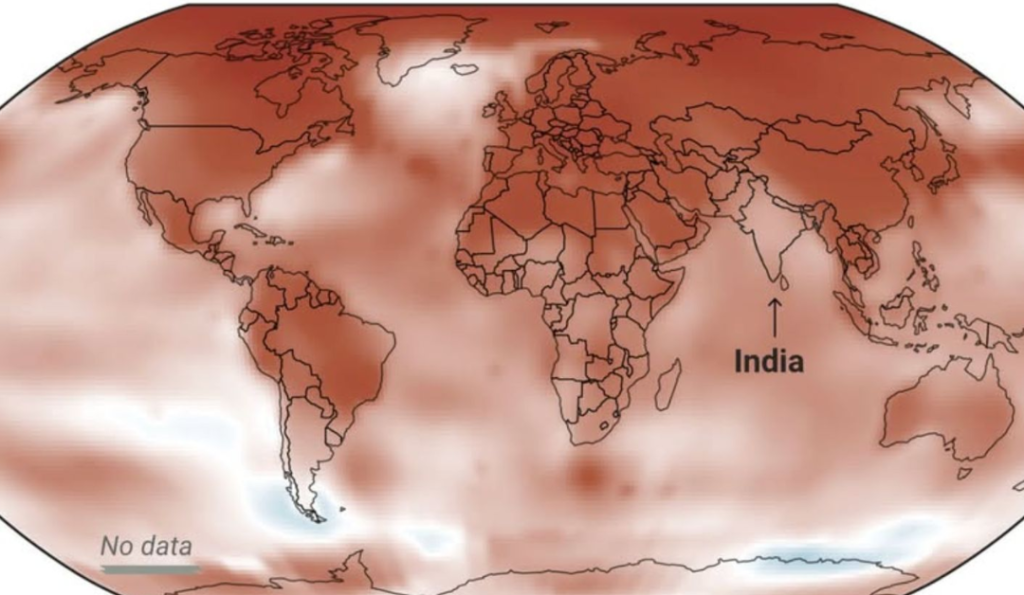🌡️ India’s Climate Enigma: Slower Warming Amid Global Heat
While much of the world is reeling from record-breaking heatwaves and rapidly rising temperatures, India presents a climate paradox. Despite its vulnerability to extreme heat and its large population, the country’s average temperature increase since 1901 has been less than 0.7°C—significantly below the global average warming of over 1.1°C.
This unexpected trend has caught the attention of scientists and environmental researchers across the globe, prompting deeper investigations into what makes India’s climate response so unique.
🔬 Investigating the Slower Warming
Several interconnected factors are believed to be contributing to India’s tempered pace of warming:
📍 1. Geographic Advantage
India’s tropical location near the equator naturally buffers it from extreme temperature variations, especially compared to higher-latitude countries. This geographical stability plays a role in reducing seasonal swings and moderating overall warming trends.
🌫️ 2. Heavy Aerosol Pollution
India experiences some of the highest levels of air pollution in the world, particularly across the Indo-Gangetic Plain. Aerosols—tiny particles released into the atmosphere from vehicles, factories, and crop burning—can reflect sunlight back into space. This process, known as “global dimming,” can create a temporary cooling effect that masks the actual rise in greenhouse gas-driven warming.
🚜 3. Widespread Irrigation
Intensive agricultural irrigation across India boosts surface moisture levels, increasing evaporation and lowering local temperatures. This “evaporative cooling” effect is particularly pronounced in northern India’s farming belts and may contribute to the cooler microclimates observed in these regions.
⚠️ A Double-Edged Sword
Ironically, while pollution and aerosols may be slowing India’s warming rate, they come at a heavy cost—posing severe health hazards and reducing air quality for millions. The challenge for policymakers is to cut pollution for public health reasons without triggering a spike in warming that these particles may have been temporarily holding back.
🌪️ Other Climate Forces at Play
Some researchers believe atmospheric circulation changes may also be affecting India’s climate. Shifts in wind patterns and monsoon behavior—possibly driven by accelerated warming in other regions—could be redistributing heat in unpredictable ways.
Moreover, the impact of aerosols isn’t uniform across the country or throughout the seasons, suggesting that more nuanced, region-specific mechanisms may be at work.
🔮 What This Means for the Future
India’s slower warming trend is not a cause for complacency. Rising sea levels, increasing frequency of extreme weather events, and persistent droughts already threaten agriculture, infrastructure, and livelihoods. As the country continues to develop and cut down on emissions and pollution, hidden warming may begin to surface.
The ongoing research into India’s unique climate trajectory is crucial—not just for the country’s future planning, but also for understanding how regional factors can influence global climate models. In a warming world, anomalies like India offer rare insights and perhaps even hidden warnings.
🔍 Ongoing Scientific Research
This phenomenon is being rigorously explored by scientists both in India and internationally. Researchers from Indian institutions, such as the Indian Institute of Tropical Meteorology and various IITs, are examining the role of aerosols, land use changes, and agricultural practices in influencing the nation’s climate. Additionally, global studies, including those conducted by the IPCC (Intergovernmental Panel on Climate Change), are working to incorporate India’s unique warming patterns into broader climate models.
These studies, which use satellite data, climate models, and long-term observations, help to uncover the specific factors that may be holding back India’s warming compared to other nations. Continued investigation is key to understanding the potential long-term effects of these anomalies on both India and the global climate.

